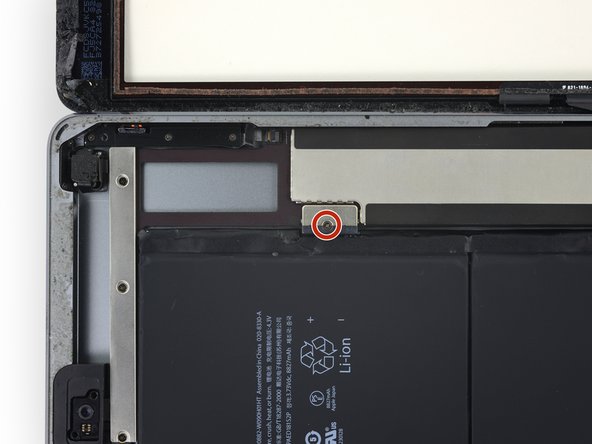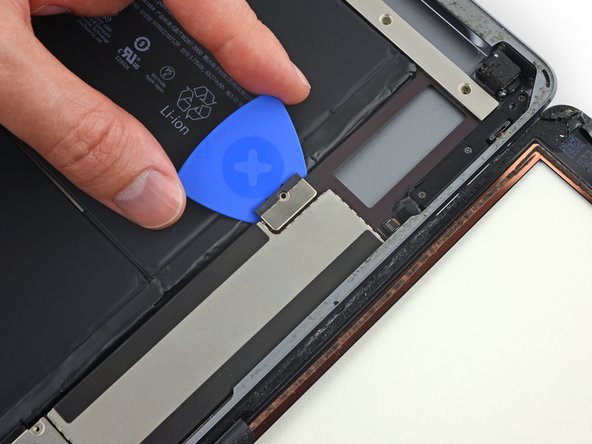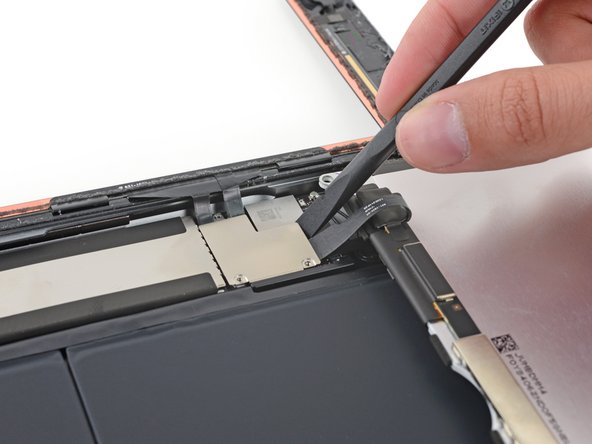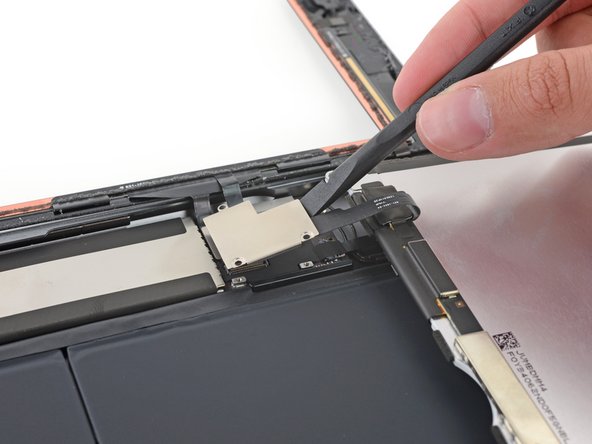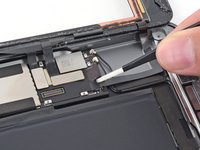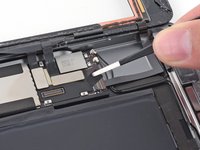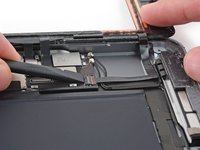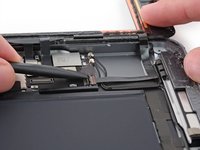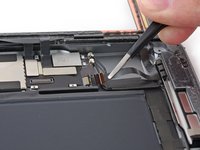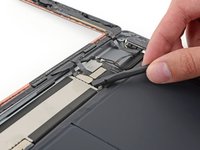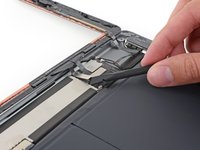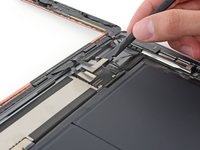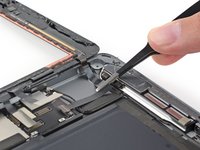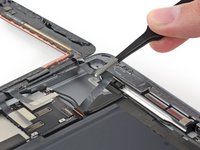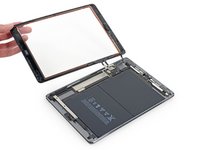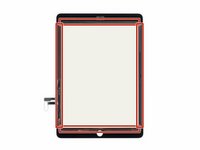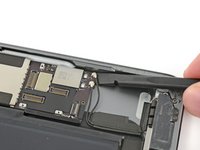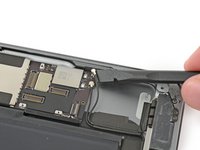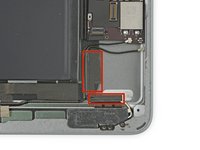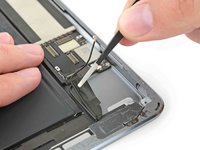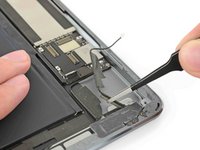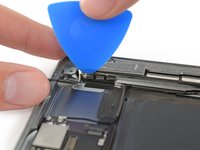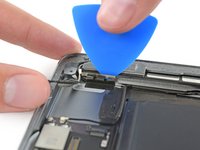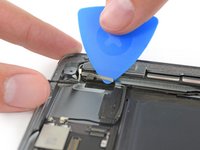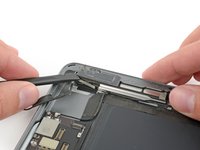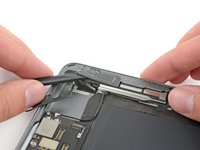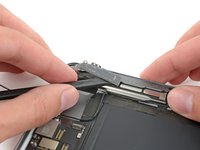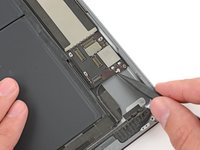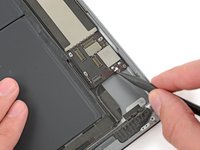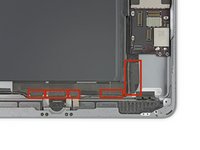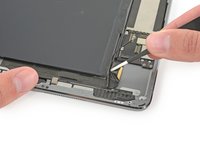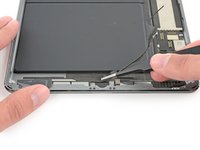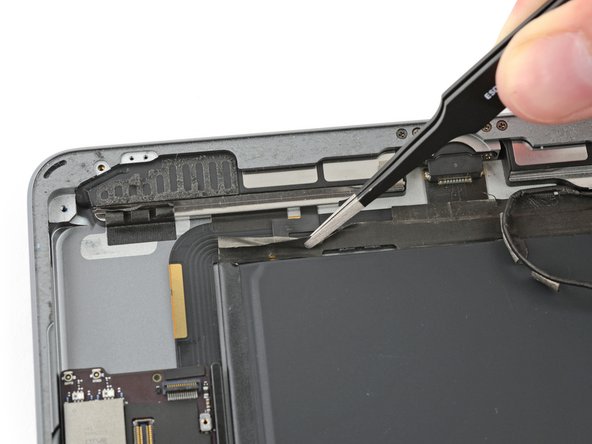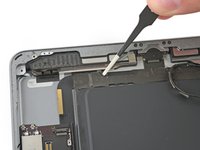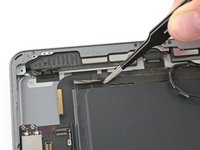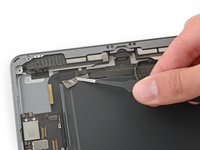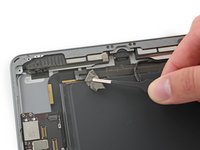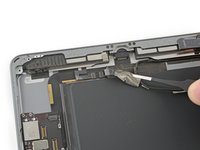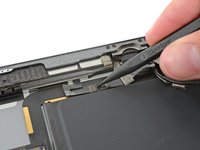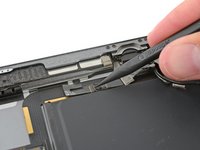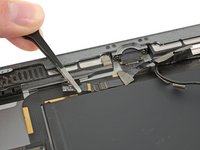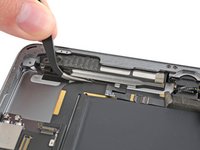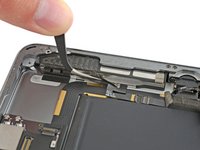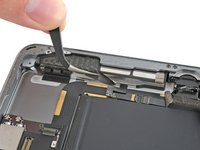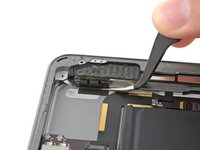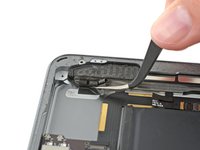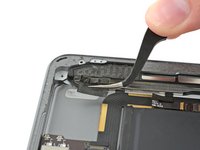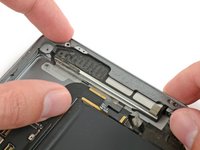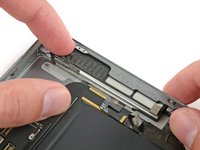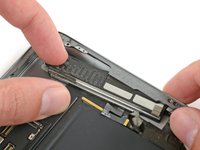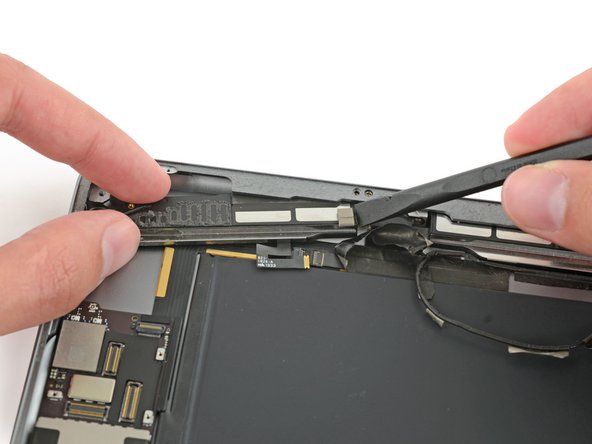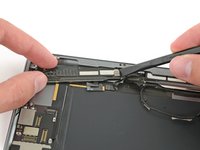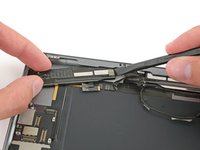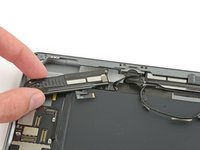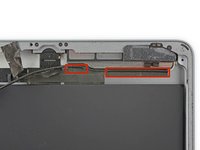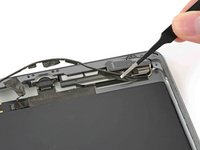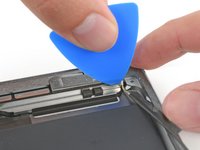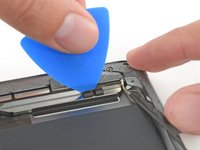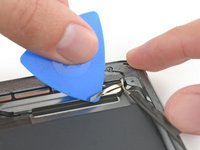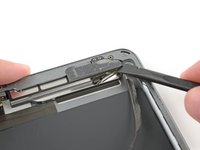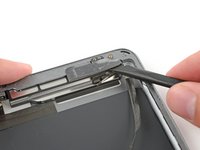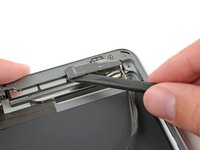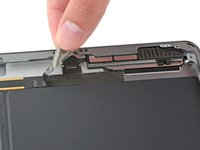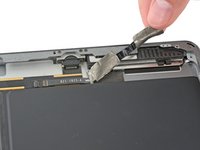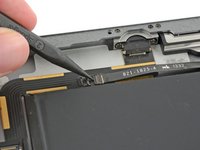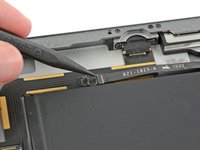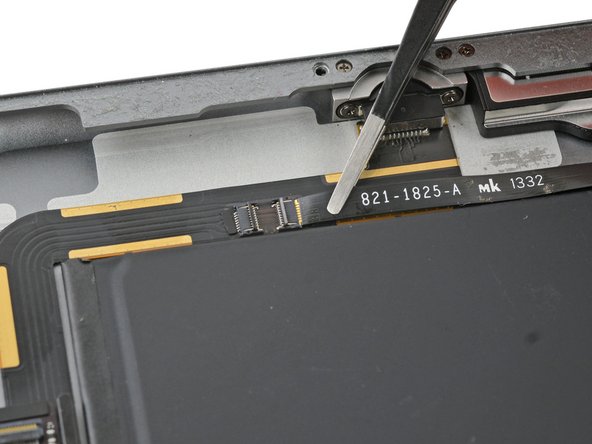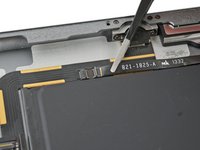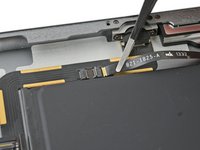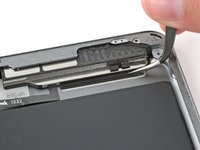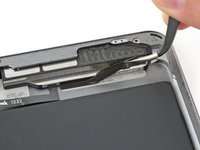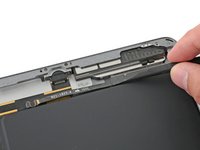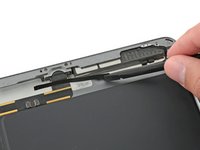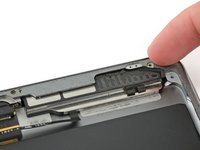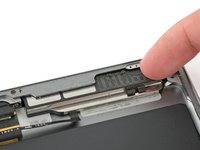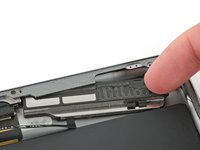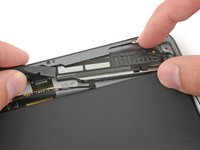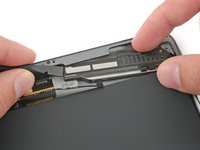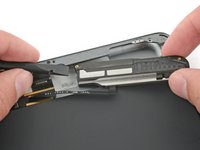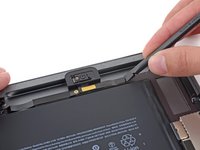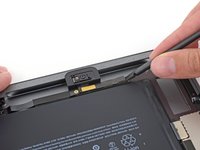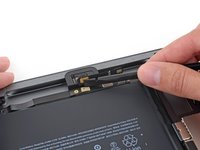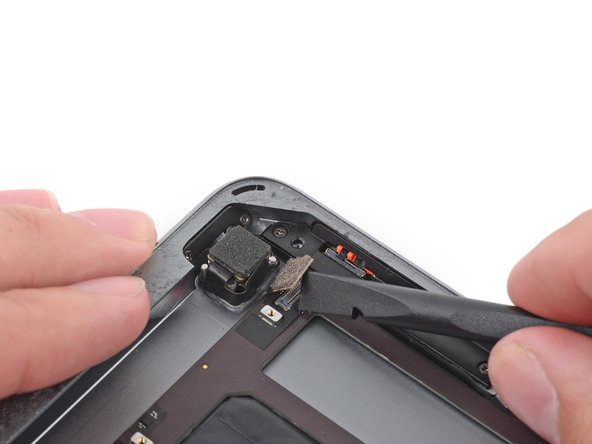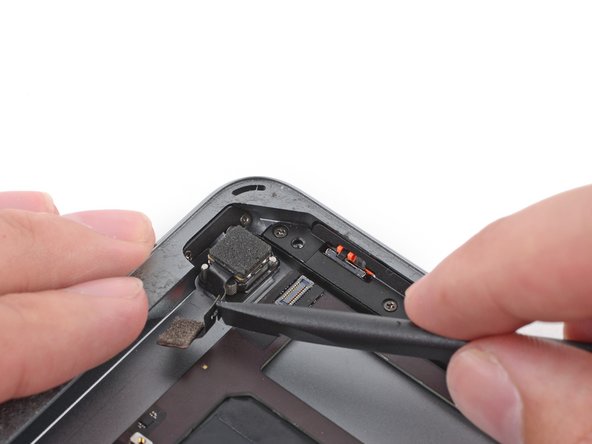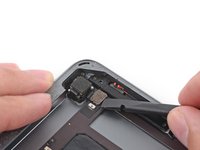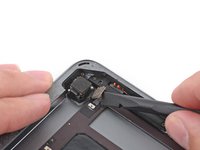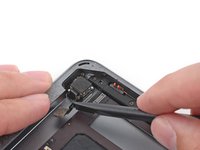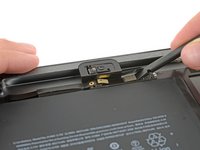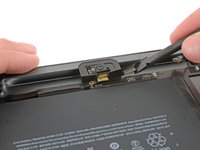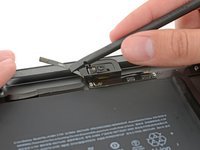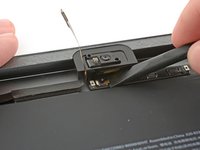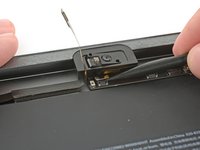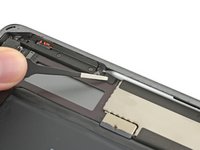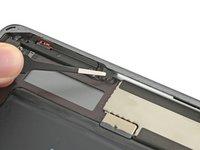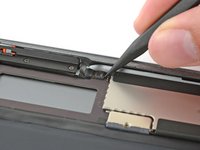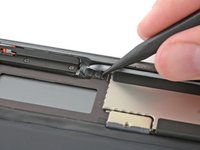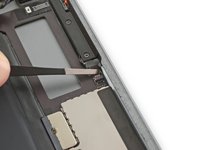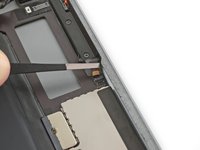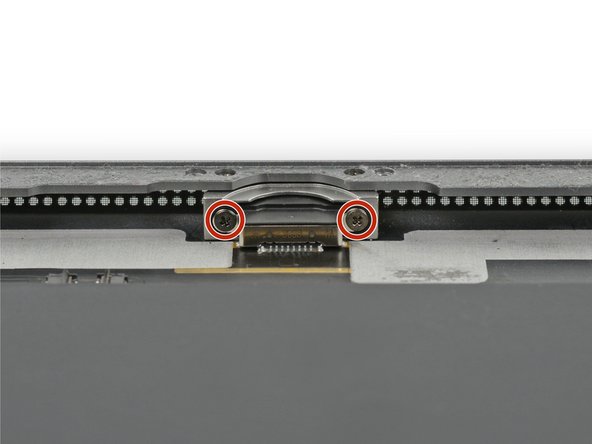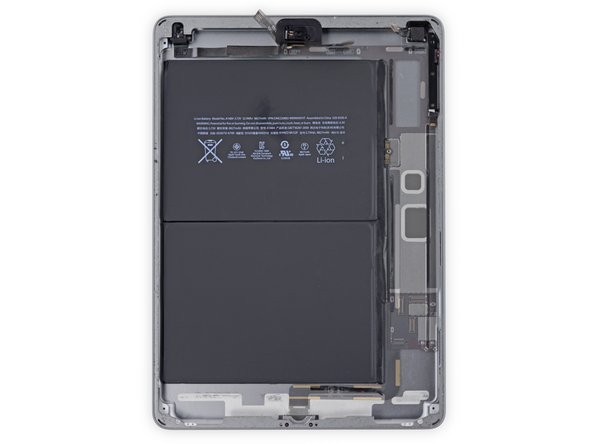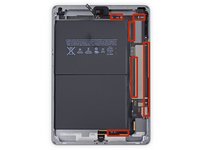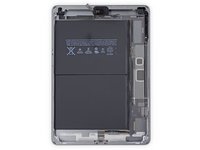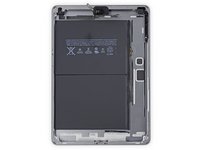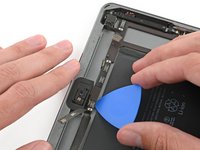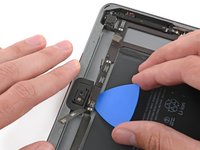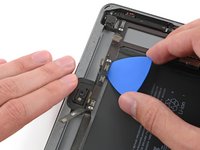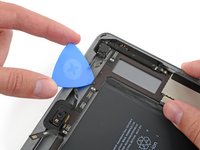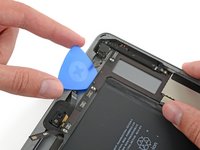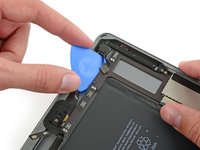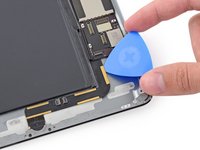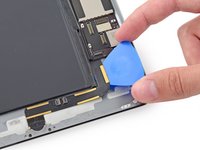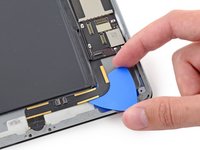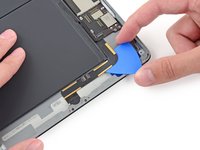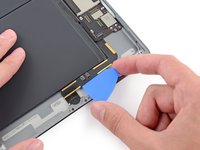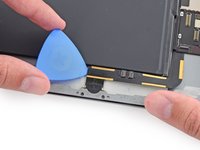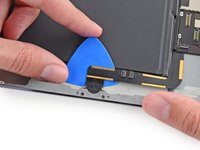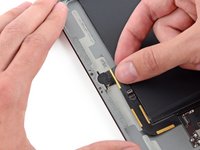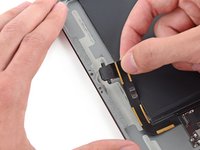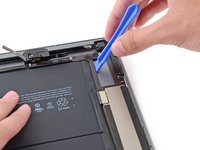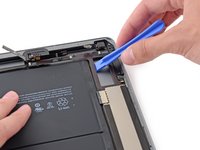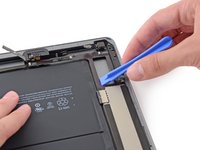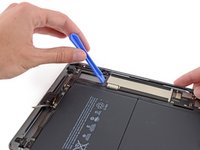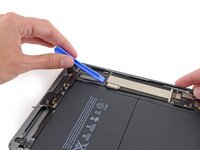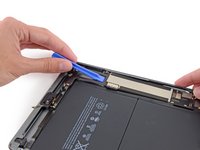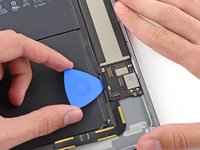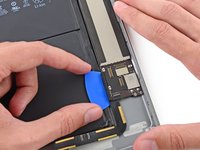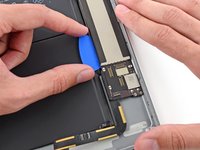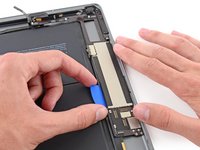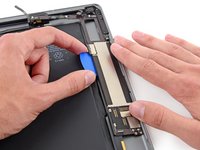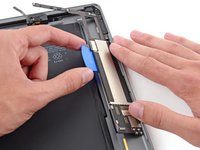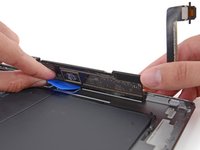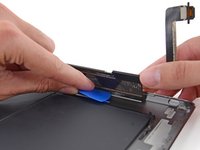Введение
Use this guide to replace a faulty logic board in your iPad 5 Wi-Fi.
Note that the logic board is paired to your iPad's home button, so replacing your logic board will result in losing the iPad's Touch ID functionality.
Выберете то, что вам нужно
-
-
Heat an iOpener and apply it to the left edge of the device for two minutes.
-
-
-
While you're waiting for the adhesive to loosen, note the following areas that are sensitive to prying:
-
Front camera
-
Antennas
-
Display cables
-
-
Инструмент, используемый на этом этапе:Clampy - Anti-Clamp$24.95
-
Pull the blue handle backwards to unlock the Anti-Clamp's arms.
-
Place an object under your iPad so it rests level between the suction cups.
-
Position the suction cups near the middle of the left edge—one on the top, and one on the bottom.
-
Hold the bottom of the Anti-Clamp steady and firmly press down on the top cup to apply suction.
-
-
-
Pull the blue handle forward to lock the arms.
-
Turn the handle clockwise 360 degrees or until the cups start to stretch.
-
Make sure the suction cups remain aligned with each other. If they begin to slip out of alignment, loosen the suction cups slightly and realign the arms.
-
-
-
Wait one minute to give the adhesive a chance to release and present an opening gap.
-
If your screen isn't getting hot enough, you can use a hair dryer to heat along the left edge of the iPad.
-
Insert an opening pick under the digitizer when the Anti-Clamp creates a large enough gap.
-
Skip the next step.
-
-
-
Once the screen is warm to touch, apply a suction handle to the left edge of the screen and as close to the edge as possible.
-
Lift the screen with the suction handle to create a small gap between the digitizer and the frame.
-
Insert an opening pick into the gap between the digitizer and the frame.
I had a screen that was lightly cracked, and when I pulled up on the glass it cracked even further and made a mess of my removal. So, I would recommend taping cracks even if you can get suction so that you don’t induce even more cracks.
I actually had a really badly cracked digitizer. Using the suction cup did nothing but shatter the digitizer more. I intentionally drove a flat head screw driver into the digitizer to reveal the recess in the body where they are showing the opening-pick. Working around the edge, the glass shattered. You still need to be careful at all of spots noted in step 2.
Do not go under the digitizer more than the 1 mm along the sides or 3-4 mm at the corners as shown in step 29 using the flat grey ring around the edge for a reference. Direct all of your tool force into the body to prevent slipping into critical parts.
The antennas at either side of the home button were the trickiest part as they were thin and slightly attached to the digitizer. I would recommend using a plastic tool for these parts if you are having to 'scrape' the glass off of the tabs of the antenna.
-
-
-
Insert a second opening pick into the gap you just created.
-
Slide the pick toward the bottom-left corner of the device to separate the adhesive.
-
Leave the pick in the bottom-left corner to prevent the adhesive from re-sealing.
-
-
-
If the opening pick gets stuck in the adhesive, "roll" the pick along the side of the iPad to continue separating the adhesive.
-
-
-
Slide the first opening pick towards the top-left corner of the device to separate the adhesive.
-
Leave the pick in the top-left corner to prevent the adhesive from re-sealing.
-
-
-
Heat an iOpener and apply it to the top edge of the device for two minutes.
-
-
-
Rotate the pick around the top-left corner of the device to separate the adhesive.
-
-
-
Slide the opening pick along the top edge of the device, stopping just before you reach the front camera.
-
-
-
Pull the pick out until only the tip is between the digitizer and the frame.
-
Slide the pick above the front camera to separate the adhesive.
-
Leave the pick near the right side of the front camera before continuing.
-
-
-
Re-insert the pick and slide it towards the top-right corner of the device to completely separate the top adhesive.
-
Leave the pick in the top-right corner to prevent the adhesive from re-sealing.
-
-
-
Heat an iOpener and apply it to the right edge of the device for two minutes.
-
-
-
Rotate the pick around the top-right corner of the device to separate the adhesive.
-
-
-
Insert a new opening pick and slide it to the middle of the iPad's right edge.
There are sensitive display/digitizer cables no less than five inches from the bottom edge of the iPad. Insert the pick further down than this, or deeper than 1mm beyond this point and you risk irreparably damaging these cables.
Three inches is much too far down this side of the iPad to use picks.
-
-
-
Heat an iOpener and apply it to the bottom edge of the device for two minutes.
-
-
-
Slide the bottom-left pick to the bottom-left corner to separate the adhesive.
-
Leave the pick in the bottom-left corner before moving to the next step.
-
-
-
Insert a new opening pick into the gap you just created on the bottom edge of the iPad.
-
Slide the pick over the antenna, stopping just before the home button.
-
Leave the pick to the left of the home button before continuing.
-
-
-
Insert an opening pick into the gap you just created.
-
Slide the pick underneath the home button and towards the bottom-right corner, making sure only the tip is between the digitizer and the frame.
-
-
-
Re-insert the pick and slide it towards the home button to completely separate the bottom adhesive.
-
Leave the pick to the right of the home button before continuing.
-
-
-
Heat an iOpener and apply it to the right edge of the device for two minutes.
-
-
-
Twist the two opening picks on the left corners of the iPad to lift the digitizer slightly, separating the the last of the adhesive in the process.
-
-
-
Lift the left edge of the digitizer upwards to further separate the adhesive along the right edge of the iPad.
-
-
-
While supporting the digitizer, slide an opening pick between the two display cables to separate the last of the adhesive.
-
-
-
Once all of the adhesive has been separated, open the digitizer like a book and rest it parallel to the iPad.
While reassembling, REALLY make sure the display cables and the home button cable won't be folded / bent while closing the digitizer. I'm not exactly sure what I did, but I broke the home button and touch ID since I bent the home button cable to the point that it broke. These ribbon cables are SUPER fragile.
-
-
-
Remove the following Phillips screws securing the LCD.
-
Three 4.0 mm screws
-
One 4.8 mm screw
Use the provided replace screen case's square compartments to place your screws into as you remove them. Really helpful and you likely won't mess up.
I tape a stripe of double sided tape on my workbench. You can place the screws on the tape on the location where the screw would be if it was in the screen assembly. In this step, your screws would be in the four corners of the tape stripe, with the longest screw (4,8mm) in the upper left corner. The other screws from the next steps can also be placed on the tape this way.
**I believe you mean the “top Right corner” Is where the longer screw goes.. not left.
! went to Office World bought 4 packs of bluetac stuck them on a sheet of paper to give approximately size and shape of iPad put it in a flat cardboard box
Where can I buy these screws please ?
-
-
-
Use the flat end of a spudger to pry the LCD out of its recess just enough to grab it with your fingers.
-
Flip the iPad LCD like a page in a book, lifting near the camera and turning it over the home button end of the rear case.
-
Lay the LCD on its face to allow access to the display cables.
Got a cracked screen from toddler stepping on the iPad. My repair went well, everything worked. Except I scratched the LCD. It seems to scratch easily.
At this step, be careful when folding over the screen, as it may scratch on the aluminum frame (third picture). When they say “soft lint free surface” that is needed, specifically where the LCD meets the frame. Place a thin cloth like sunglass cleaning cloth over the edge of the frame.
Thank you, very much, for this tip.
At this step, possibly depending on date of manufacture, there may be black silicone present on/around the four screws that mount the display. It needs to be carefully scraped away and the two screw mount holes at the top of the screen pried up and away from the chassis. Between the chassis and the plastic portion of the mounting frame, there is a slim sheet of metal. Be sure to pry this off WITH the mounting frame. It is part of it. DO NOT try to separate it.
-
-
Инструмент, используемый на этом этапе:Battery Blocker$3.99
-
Remove the single 2.3 mm Phillips screw securing the battery connector to the logic board.
-
Slide the battery blocker underneath the battery connector area of the logic board, and leave it in place while you work.
Not having the isolation pick, I used 2 thin guitar picks instead, which did the job fine.
I couldn't disconnect the battery connector - I applied some force, nothing happened and I was afraid of applying too much force - so I just left it connected and I was very careful not to short out any terminals with metal tools. I completed the repair without any other issues and the iPad now seems to be working fine.
Mine was missing. Made one with scissors but still didn't do the trick. I just worked with the batteries still plugged in.
Couldn’t get the battery terminal disconnected so I continued with repair. I didn’t short anything but now it won’t do anything. It worked before, just a cracked glass to replace. Any solutions?
Why do you say you didn’t short anything? Your result would seem to suggest otherwise
I don’t know if it applies to the iPad Air, but I saw elsewhere in my researches in reference to a iPad mini (or was it an iPod mini?) that disconnecting the LCD and/or digitizer with the battery still connected will blow a “fuse” for the backlight. Might yours still be working, just with no screen illumination whatsoever? Dunno. Just a thought.
It apparently can be repaired, but is no longer a DIY job.
Tim -
try lifting the board and not blocking the connector. If you block the connector there are pins that could be damaged.
A replacement of the battery connector is required if pins are bent should you get power on or charge issue after battery disconnection. This can be replaced with the right tools and low melt solder to remove the connector and replace.
Best method to disconnect battery is to carefully lift the logic board near the battery connector enough to slip a piece of thin plastic or paper between the batter connector and the logic board battery connector and pins.
Failing to isolate battery so can result in blown back light or touch filters or diodes in backlight circuit.
At the very least run down the battery flat prior to repair but you are really best to isolate battery.
From a repair point of view. This connector is a royal pain. For assembly it's great, well, nearly great.
This connector is SOLDERED to the motherboard side. Never lever this on the motherboard side, I will call it the right hand side. It will break leaving it's soldered pins behind. Yes I did it.
The pins, on the battery side of this connector, just rest on the batteries plated pads. They are kept under tension by the screw. It should be noted though that removal of the screw will not disconnect the connector pins from the battery pads. Natural tension is still present.
I suggest strongly that you take a look at the battery connector online to see the nature of the pins and you will see that some are quite delicate.
The tools purpose is to raise the battery side of the connector ; the left side, so there is some clearance between the pins and the batteries pads. If you have seen a picture of this connector then you will realise the potential of damage to this connector and will have a better idea of what to do.
Contd.
Lifting the connector and simultaneously sliding a thin piece of card or plastic under the pins should be done carefully. In fact, to minimise damage I just slid it under ONE of the main battery pins, plus or minus, which are in the middle and quite robust compared with the tiddlers on the side of the connector.
The second point, the battery and the motherboard have protection circuitry. When I broke my connector the battery dropped to 0.5V at the terminals. Connecting the charger, when all the connections were sound and not shorted raised it from the dead back to over 3.2V
I replaced the battery, and got things hooked backup. For the test, the screen came on, digitizer seemed to be functioning fine. But I couldn’t get it to charge. I used the i-fixit battery blocker by using my spooger to put a little up pressure on the board, and then sliding the blocker in. I don’t think I damaged the pins, but its possible. This is a friends ipad, and its obviously been dropped a few times. I started eye balling the charging port, it LOOKS ok, but looks can be deceiving. When plugged in, even trying different cables, the ipad is not showing the charging symbol. Some of the comments here seem to imply, if I damaged the battery connection pins, I would still get a charging symbol. My question is, if I damaged those battery connector pins, would the ipad show the charging icon or not? Should I be looking at replacing the charging port?
-
-
-
Remove the three 1.4 mm Phillips screws from the display cable bracket.
Be careful when re-installing screws on reassembly. I mistakenly put the longer screw from the battery connector in the outboard hole, and wound up twisting off the lug that is only lightly soldered to the metal below. Still have 2 screws and system seems to work fine.
-
-
-
-
Use the flat end of a spudger to gently pry the display cable bracket straight up from the logic board.
bough my digitizer from ebay and have everything done up to this step. The screwdriver the kit came with said to be a #000 but it stripped the screw on the plate... I have tried rubber bands, tape and paper to no avail...anyone got an idea on how to remove the screw. Also I am currently studying in St. Kitts and they lack some products found in the US.
I'm sure you've moved past this by now, but I've had some success with stripped screws using a comparable, if slightly larger flathead screwdriver. The screwdrivers that come in those kits tend to suck quite a lot... iFixit actually has a guide for stripped screws: How to Remove a Stripped Screw
-
-
-
Remove the LCD.
Andddddd continue this iFix folks! It's not a matter of working backwards. Most people must have cracked screens and end up having to rip the screen off and won't have a chance to inspect connections.
He is far from complete…..if lcd is being replaced its probably because top screen is busted too. He didn’t show anything about how to remove the cables for that.
There is a separate guide for replacing the outer glass ;)
-
-
-
Remove any tape covering the home button ribbon cable connector.
I totally skipped steps 39-98 I didn’t see any need to remove all these components and the logic board just to get the battery out. I gently pried up the board where the battery connector goes in, slipped it out, and slipped in the new one.
That is a great tip. There is plenty of space inside the case to lever out the battery without taking out all of the components. I laid the iPad on top of a large bean bag, heated for 3 minutes in the microwave. After 4-5 minutes, I was able to lever out the battery with the spudger and the credit cards. It came out after a few minutes of careful levering and cramming the credit cards under the battery. I unscrewed the earphone connector and carefully taped it back to the iPad housing with paint tape to have more room to maneuver.
I second this.
Just be careful to make sure you don’t squish or tear any wires or anything else surrounding when you’re fighting with the batteries, and it’s still way easier than removing everything else in there first.
I’ll add one bit, though. The hole in the battery connector that accepts the screw through the logic board also apparently slips over a pin in which the screw seats. I couldn’t see that. So when I got the last bit of battery adhesive to let go, the pin tore out the battery connector hole. Since I was replacing the battery, it wasn’t a problem, but did produce a little conductive piece that I had to fish out before putting anything back together. Wouldn’t want that little torn out piece running around in there to short something out later.
Also, that pin will locate the battery correctly, so that in one of the last steps of reassembly, the battery connection screws together properly. Make sure you find it before the battery adhesive grabs on to the back of the case.
Tim -
Careful removing the tape. The home button has a zif connector and if you aren’t careful the tape can rip the zif flap right off. You might have to hold it down while you pull it off or pull the tape from a different direction to make sure you dont tear the zif tab off.
-
-
-
Use the flat end of a spudger to flip the tab on the home button ribbon cable ZIF connector upward.
-
Carefully pull the home button ribbon cable horizontally out of the ZIF connector.
I got through the repair, only to have the new screen give me problems that I can not find solutions to any where. The digitizer is working on its own without my input, it will start apps, switch windows, etc. I have pulled up the new screen and checked my ribbons and cables seem to be fine. ANY IDEAS??
Moses Roman
Same exact problem that I have. I think it has something to do with the glass touching the ipad. Something like on the iPad mini, where you had to cover some areas beside the home button.
I would love to see a real solution, as im stuck with unhappy customers and frustrated me :)
I had mine replaced TWICE by a local repair shop. Soon noticed both times that the iPad would soon go haywire after a few minutes use with random clicks, ghost typing, opening apps, etc.
The iPad Air's such a poor quality, un-durable product anyway. I only had my screen replaced in the first place because it cracked with no apparent drop or trauma and Apple wouldn't replace.
I have also the same issue, does anyone know what the problem is?
Please give us some feedback.
Have seen this with multiple repairs where the digitizer was replaced. In each case it was a problem with the digitizer cables where it gets tucked under the glass near the edge of the frame. Not yet sure if they are badly made digitizers or if the cable gets damaged trying to tuck it under frame during installation.
To avoid the digi sending the ipad crazy. In the same way you tape the copper/silver edges on the back of the glass for the iPad Mini. You tape all the way around, making sure not to dirty the protective cover when placing back down after taping one edge.
Make sure all the metal surround is cover by tape, but careful not too go over the edges too much. It will be visible when using the device.
Like i said earlier, the real skill is not too dirty the screen when lifting the protective sheet.
Have fun!
Thanks man, I'll give it a try. Any idea what kind of tape should I buy?
Kapton tape otherwise known as heat tape or polyamide tape
Just fitted the screen, the digitizer works, display all good but I had a message saying I could not use touch ID and the home button doesn’t work at all…is this expected?
I break the ZIF connector. Is tat touch connecter.?
How do you take the ribbon cable off from the home button site???
-
-
-
Use a the flat end of a spudger or a fingernail to carefully pop the two digitizer cable connectors straight up from their sockets.
What are those connectors for because i kinda half broke the left one on the screen on the glass frame and now the lcd wont turn on
-
-
-
Carefully peel the home button ribbon cable up off of the adhesive holding it to the rear case.
THIS PICTURE IS PERFECT AND PERTANANT TO THE NEXT STEP REGARDING “GHOST OR PHANTOM TOUCH” - See that foam around the edges? For some reason, the ifixit replacement digitizer doesn’t come with it (but it does come with new adhesive applied already.) With your screen, also purchase their “tesa tape” : Tesa 61395 Tape / 4 mm - it comes in different widths fyi. I choose 4mm as advised by a staff member.
On the replacement screen I received from you, the home screen ribbon cable does not fully seat inside the Zif connector like the original and will not lock in place as a result. It seems too fat. Any tips to make it work?
I can’t think of any reason for that other than it’s the wrong display for your model, or it’s defective. Double-check the model very carefully and make sure you ordered/received a compatible part. If you ordered from iFixit, contact customer support directly for returns or exchanges. Good luck!
I didn’t receive any of the two sided tape…I assume it needed to be ordered separately??
So, when I removed the glass, the bottom cable tore and I have to replace it. The video is not as clear regarding replacement. The old button had a round rubber gasket but the new one does not. No inst. how to re-use it. I can’t attach and keep in place the new button.
In a previous repair, i broke the zif, what you want to do is hold it down while removing the tape, otherwise it will pull the parts up with it.
Since it was broke i put a piece of electrical tape on top for the pressure the zif would push down, then another piece from the screw hole to the bend in the cable, so it does not come loose when putting back together.
-
-
Инструмент, используемый на этом этапе:Polyimide Tape$9.99
-
Remove the front panel assembly.
-
If you experience "ghost" or "phantom" touch input issues with your new display, this can be resolved by adding a layer of very thin insulating tape, such as Kapton (polyimide) tape, to the highlighted areas on the back of the panel. iFixit panels come with the proper insulation, and should not require the addition of any tape.
In your conclusion, which doesn't have a comments area, you say to reverse the procedure - simple enough, BUT what about the sticky adhesive residue along the edges of the (a) the just-remove-glass (if re-using) and (b) along the 'inside' edges of the iPad chassis? Typically Apple says to remove the adhesive residue (careful) with alcohol wipes (lint free & 98% isopropyl). Thanks for the instructions!
the hardest part of this repair for me is actually aligning the ribbons (especially on the aftermarket version) so they don't jumble and cause the glass to mush away from the adhesive leaving a gap. Would would be very helpful to see how to fold the ribbon cables back on the aftermarket digitizers. They are slightly different than the originals, or at least they appear different. This repair is super useful but we could really use a step 44 because re-assembly has a sequence and a folding technique.
The ribbon cable is a little tricky to figure out. But if you look closely at the old ( Broken) screen you will see they stick to the underside of the screen thin the remaining ribbon slides down into the ipad between the display and ipads frame.
I used a heat gun and suction cups to loosen screen.
This was a very good ifix ii
This is what I need too!
It is not as simple as reverse disassembly steps, the ribbon cables need to be tucked into the pocket on the side of the iPad. There is tape on them that has to adhere to the side of the digitizer too. Mine did not make it all the way down into the gap, and stuck on the other adhesive, now I have a gap by these two cables. To tuck these into this area is difficult at best. I now need to remove the glass, hoping it does not shatter and purchase more tape.
Other than this the task was not bad.. BTW: YES People use the capton tape
I’ve read that people are putting glue at each corner. I haven’t figured out what glue. One person said Glue Dot 1” 16lb, another said rubber cement, 1 video shows 5 min epoxy… Heard that some sort of glue (not super glue) needs to be used to avoid the glass lifting later on. And to use 3m red tape along the edges. I’ve been searching for which glue because I still have an ipad air to do screen replacement on.
Would be helpful if the tape were listed in the master supplies for the guide. I got the whole kit overnighted, but then had to wait a week to get the tape from Amazon (since I wasn’t going to shell out another $50 for overnight shipping). Otherwise, it’d be nice to know if the displays through iFix it included the foam or not—mine didn’t.
Second the concern about the foam. I bought the full repair kit, but was surprised there wasn’t already polyimide tape on the digitizer or in the kit. At least mention that it needs to be purchased extra.
@baron9 The displays we sell have the proper insulation and don’t require any tape. That note is more for folks who use our guides while buying the parts from somewhere else. (They tend to complain here, even though it’s the part that’s at fault, not the guide.) I’ve updated the instructions to try to make things a little more clear. Sorry about that!
My digitizer kit from ifixit also looks like it is missing the polyimide tape on the digitizer. Can someone confirm that i do not need to get the tape with the original ifixit kit and just slap the digitizer on there?
Alex -
I did not realize that aftermarket screens (besides the one ifixit sells) do not come with adhesive strips. Well worth the time to figure out what kind of adhesive you’re going to use to re-adhere the glass before you begin. Stopping while you’re so close to the end of the repair (or having to open the ipad up again after the screen doesn’t stick back down) is slightly frustrating.
I used a b-7000. 48 h cure time.
Just wanna say thank you. I replaced my LCD and digitizer today…. took a LOT longer to get that adhesive off than I expected. And the IOpener busted in my microwave despite following all directions (eg only 30 sec at a time, out for at least 10 min before reheating. So that sucked. Turns out the rice in a sock worked pretty well too.
Regarding assembly: even with carefully tucking the ribbon cables down the side while reassembling, it’s still hard to get that area to stick down.
Some advice when reassembling that I have learned in the hard way.
One good hint is to those who buy replacement parts that are not exactly the original ones. Some of the parts come with a 3M adhesive tape on the tab of the flex cables (I guess original parts are already folded and glued). I would strongly recommend to be very careful when you try to glue it on the front panel and maybe watch a video on how to fold it properly, so as not to fold or pinch the flex cable on an unrepairable way. Also, some of the low cost parts come with a very strong protection sticker on the front glass. It is advisable that you peel off the sticker before reassembling the ipad in order to not end up ruining the glue that was supposed to hold the front panel .
-
-
-
Insert a spudger under the antenna cable closest to the edge of the iPad and lift upward to disconnect the antenna cable connector.
Skip to the step 98 or even 100 if you just need to replace the power button - I think you should even consider this to replace volume buttons. I am fixing mine right now and screwed up the speaker cable. I did follow the instruction but totally missed the cable right below the tape. I proceeded further, but I just realized I didn't have to go through all the troubles. I wish ifixit.com can manage this type of direction clearly so that dis-assembly is minimum.
After you replace the Digitizer if you are getting random key presses it is likely to be because Kapton tape has not been applied to the edges of the digitizer. You need to cover the silver strip around the edge of the digitizer with kapton tape before reassembling. Works every time.
This is my first ipad and when the battery dies, it will be my last, way overrated and no options like memory cards or mini usb ports, and the battery thing is ridiculous,I wish I would have never bought this knowing this stuff , and way over priced.
It always helps to Google something before buying it. "iPad Air reviews" in Google would have saved you. I just find it funny how in this day and age, people STILL make "purchase mistakes" because they didn't take the time to research the several-hundred-dollar device they are about to commit to purchasing. You should have seen the amounts of research I did before buying my $1,399 Asus G751JY laptop. I'm absolutely pleased with it and am happy I don't deal with issues other people have. Just be weary, buddy. ALWAYS GOOGLE.
Scott S -
If you just want to replace the battery, skip to step 99. You can easily get to most sides of the battery without removing all other components. It worked for me. Good luck!
I wish I read this comment. Would have saved me a lot of time.
leo -
I followed your piece of advice and went to step 99. My new battery works just fine without removing all those components including the logic board - thanks a lot!!
An important note - as per the comments lower down, you can skip ahead to step 95 (unsticking the battery) just fine if you're just changing the battery, but after you've unstuck the battery you will need to go back to step 88 and soften the logic board adhesive so you can pry it up about a cm and lift the battery terminal up and over the post to remove it. I didn't realise the post was there, and broke off a piece of the original battery terminal that got stuck under the logic board. This prevented a good connection with the new battery, and caused random restarts after I put everything back together until I realised and went back to recover it.
Don’t skip to 99 because you need to remove the logic board.
I have successfully replaced the Battery without removing any components other than the Screen Assembly and LCD. You can skip steps 44 thru 99 by using a spudger as a wedge to lift & hold the Logic Board high enough to lift the battery contact over the post that holds it in place… this will save you a lot of time and frustration and makes the repair sooo much easier.
My goal was to replace the battery. As some suggested I skipped some steps. I did Step 46 and left out 47 to 100. But I think Step 46 can be skipped too. iFixit probably does not recommend skipping these steps because it is riskier to bend the batteries and damage them. But if you work carefully enough and make sure the adhesive has been softened well, you should be fine. It was no problem for me. It saved me quite some time. (I will write a comment in Step 102 to help you get the batteries out without Steps 46-100.)
-
-
-
There are two large pieces of tape wrapped around the right antenna cable, securing it to the rear case.
-
Peel the tape up from the rear case.
You may partially skip steps 46 to 100, as it is not really mandatory to remove all those parts in order to remove the logic board and the battery.
-
-
-
Carefully insert an opening pick between the speaker enclosure and the antenna cable bracket.
-
Slide the pick toward the home button to cut the adhesive.
-
Push the bracket away from the speaker until it clears the tape underneath.
The pick was not thin enough but the razor worked.
In my view there is a few destructive steps here. I have been able to remove this entire assembly by lifting only the adhesive tape anchoring it to the back without touching this fine metal bracket as touched in in Step 46 & 63 or tearing the foam in Steps 48 & 65 on both the left & right sides. Remove the screws as in Step 47 & 57 and the one’s either side of the charging port in 64 & 71. Once removed, the only thing securing these to the rear is adhesive tape. Lift the tape and walk the units out by nudging them from side to side.
Thanks. Made the whole next chunk much simpler :)
-
-
-
Remove the following Phillips #000 screws securing the right antenna:
-
One 2.3 mm screw
-
Two 1.4 mm screws
I would strongly advise not to follow this step and following ones: removing the 2 Wi-Fi antennas is not required for complete disassembly of the motherboard and battery, and you may potentially destroy your antennas: I scrupulously and foolishly followed this tutorial step by step and now I have severe Wi-Fi problems on my iPad because one of the 2 antennas has been damaged during the process (and by reading all the comments on this page you'll see that I'm not the only one to have this issue...).
=> As someone else already mentioned it in the comments, just skip most of these steps and go directly to something like step 79.
-
-
-
Insert the flat end of a spudger between the antenna and the speaker assembly.
-
Slide the spudger toward the home button to cut the foam adhesive securing the antenna.
Este paso es innecesario, ya que con solo quitar los tornillos es suficiente, no hace falta despegar la goma espuma que mantiene la antena de la bocina.
tout a fais il n'est pas nécessaire de décoller l'antenne du haut-parleur ! Il faut juste enlever les vis et continuer le démontage du haut-parleur en laissent l'antenne fixer a lui !!!
Faire de même pour le deuxième haut-parleur !
-
-
-
Insert a spudger under the left antenna cable and lift upward to disconnect the antenna cable connector.
-
-
-
There are five pieces of tape wrapped around the left antenna cable covering the right speaker cable connector.
-
Peel the tape up from the rear case.
-
Fold the antenna cable out of the way.
This step was not very well explained. It fails to mention the speaker cable attached on to the tape. This caused the speaker cable to be torn since it is so thoroughly attached to the tape. Guide made no mention that it was under there or that you should be careful about it. Not even the usual remove the tape gently they just tell you to rip it right off no problem. Not sure how this was missed when the guide was so thorough about this beforehand.
Approx. 3/4 of an inch past the bend in the cabling underneath the tape lies the right speaker cable. Beyond this point proceed with extreme caution. Delicate cables and ZIF connectors underneath the tape will be torn or damaged if they aren't separated from the underside of the insulation tape first. Use fingernails or thin-edged tools.
An update to this would be nice. Will the Ipad work with a broken spaker cable? Is it possible to get replacement part? Maybe this step should be rewritten.
-
-
Инструмент, используемый на этом этапе:Tweezers$4.99
-
Instead, grip the tape just under the speaker and peel it down, away from the edge of the case.
-
-
-
Use the pointed end of a spudger to flip up the retaining flap on the right speaker cable connector.
-
Slide the speaker cable straight out of its ZIF connector.
-
-
-
Insert a fingernail or the flat end of a spudger in the groove in the speaker housing, near the corner of the rear case.
-
Pull the speaker down, away from the corner of the case.
-
-
-
Use a spudger to help pull the speaker out from under the edge of the rear case.
-
Remove the right speaker from the iPad.
When did you remove the blocker after installing the battery blocker? No photos with blockers after this procedure.
-
-
-
Remove the three 1.4 mm Phillips #000 screws securing the upper component cable bracket.
-
-
-
There are two remaining pieces of tape securing the left antenna cable to the rear case.
-
Peel the tape up from the rear case.
-
-
-
Carefully insert an opening pick between the speaker enclosure and the antenna cable bracket.
-
Slide the pick toward the home button to cut the adhesive.
-
Push the bracket away from the speaker until it is clear of the tape underneath.
-
-
-
Remove the following Phillips #000 screws:
-
Two 1.4 mm screws
-
One 2.3 mm screw
I didn’t need to take the left antenna and speaker out. If you just get the wire and tape out of the way so you can unplug the speaker flex cables and take out the lightning connector, then you should still be able to get the logic board out. the left speaker isn’t in the way at all.
-
-
-
Insert the flat end of a spudger between the antenna and the speaker assembly.
-
Slide the spudger toward the home button to cut the foam adhesive securing the antenna.
Este paso es innecesario, ya que con solo quitar los tornillos es suficiente, no hace falta despegar la goma espuma que mantiene la antena de la bocina
-
-
-
Remove the tape covering the left speaker cable connector.
-
-
-
Use the pointed end of a spudger to flip up the retaining flap on the left speaker cable connector.
-
-
-
Gently fold the left speaker ribbon cable up so that it will clear the battery when you slide the speaker enclosure out.
-
-
-
Insert a fingernail or the flat end of a spudger in the groove in the speaker housing, near the corner of the rear case.
-
Pull the speaker down, away from the corner of the case.
-
-
-
Use a spudger to help pull the speaker out from under the edge of the rear case.
-
Remove the left speaker from the iPad.
-
-
-
Use the flat end of a spudger to disconnect the front-facing camera connector from the logic board.
-
Fold the front-facing camera cable out of the way.
-
-
-
Use the flat end of a spudger to disconnect the rear-facing camera connector from the logic board.
-
Fold the rear-facing camera cable out of the way.
-
-
-
Use the flat end of a spudger to disconnect the headphone jack connector from the logic board.
-
Fold the headphone jack cable out of the way.
Note for others. On this connector, i have some tape keeping it down, it's rather difficult to remove without ripping it. So i ripped the tape to remove it.
"Ripping" the tape seems ill-advised. A sharp ceramic craft paper cutting knife or the very tip of a fine-tip Exacto blade work well. Once the tape is cut on one side, the blade slides through it like it's nothing. Zero force required.
Be careful not to insert a blade too far or it may come into contact with conductive components.
-
-
-
Use the flat end of a spudger to disconnect the microphone cable connector from the logic board.
-
-
-
Use the pointed end of a spudger to flip up the retaining flap on the upper button assembly cable connector.
-
-
-
Remove the two 3.3 mm Phillips #000 screws securing the Lightning port.
NOTE for others who might miss this: this picture is looking down, out the bottom of the iPad. There are four other screws near the lightning port, two for the speakers and two for the port. You see these four easily, looking down at the battery and motherboard. These two are additional to those, and perpendicular to them. Both pairs of lightning port screws, one set perpendicular to the other, must be removed.
Where did the battery blocker go? It was introduced in step 35. Nowhere has it been said it can be removed . . . yet it is now absent in this picture. I took it out when I got to steps 93-96.
Yes this is a deceptive image as the battery and connector strap seem to be missing. Hold your iPad vertically and look down at the lightning port and you’ll see these hidden screws.
Thanks for your comment! I’ll add a note in the step.
-
-
-
The adhesive is in the form of six pieces of black foam tape—refer to this step as you work at heating and prying to keep track of where each piece is located.
Thread a piece of dental floss under the tip of the logic board. Be careful when rounding the corner not to snag any ribbon cables. This easily released the foam tape up to the battery connector.
Les 2 images suivantes sont contradictoires. elles donnent l'impression de devoir enlever la carte mère.
@totoy Effectivement, cela peut-être perturbant, mais ces images servent de référence et expliquent où se trouvent les six morceaux d'adhésif qu'il va falloir décoller au cours des étapes suivantes pour retirer la carte mère.
-
-
-
Place a heated iOpener over the rear-facing camera end of the iPad, and let it sit for at least a minute to soften the adhesive through the rear case.
-
-
-
Carefully insert an opening pick under the logic board, between the front-facing camera and the battery.
-
Slide the pick toward the front-facing camera connector, and stop at the bend in the logic board.
-
-
-
Slide an opening pick under the logic board from the front-facing camera to the rear facing camera.
-
-
-
Insert an opening pick under the Lightning cable where it meets the logic board.
-
Slide the pick down and around the bend in the cable.
-
-
-
Continue to slide the opening pick under the cable, stopping before the cable bends to the Lightning connector.
-
-
-
Finally, slide the opening pick between the battery and the Lightning connector itself to separate the last of the adhesive underneath the cable.
There are two screws holding the lightning connector to the rear case, I didn’t see them in this guide. I recommend removing them before you attempt to remove the lightning connector, otherwise you’ll look like an idiot struggling with it for around 1/2 an hour like I just did.
Did you skip this step?
I had this problem too!!
Will Young is correct. The two extra screws are horizontal - they are in addition to the vertical screws mentioned in step 82.
@usablethought AFAIK there are only two screws securing the actual port to the chassis. You can tell by looking at the part—there are only two screw holes. Those additional screws can be left in place, as shown in the photos. At least, that was my experience. If you’re working on a different model, then of course you may need to improvise—the instructions are only for the model indicated.
-
-
-
Pull the Lightning connector straight out of its recess in the rear case.
there were two screws holding the lightening connector in place on my iPad
Yep! In this guide those screws are removed in Step 82, but you can remove them at any point prior to taking out the Lightning connector.
CAUTION - there are two ‘hidden’ screws holding the lightning port that face the battery. Hold the iPad vertically and look down to see them. I almost broke the cable trying to remove it thinking it was just stubborn adhesive. Yes its mentioned at Step 82 but its a confusing illustration and easily overlooked.
-
-
-
Place a heated iOpener on the left side of the rear case, where the logic board is adhered.
-
-
-
Insert a plastic opening tool in the rectangular gap in the upper area of the logic board, and pry the logic board up from the rear case.
-
While keeping the opening tool underneath the logic board, slide it down the length of the gap to free the upper end of the logic board from the adhesive.
-
-
-
Pry up the logic board at the lower edge of the rectangular gap, near the EMI shield.
-
-
-
Slide an opening pick under the logic board between it and the battery.
-
Slide the pick from the base to the center of the logic board to cut the adhesive.
-
-
-
Slide the pick up the length of the logic board.
-
Once the adhesive has been cut, pry the battery side of the logic board upward off of the rear case.
Don't touch the small components which are under the motherboard !!! If you do it your iPad is definitively dead.
-
-
-
Continue to lift the logic board along the edge nearest the battery, until you can get an opening pick against the far edge of the logic board.
-
Cut any adhesive holding the outer edge of the logic board to the rear case.
-
-
-
Remove the logic board from the iPad.
Nice guide, thank you, very helpful. There would be no way to guess where the glue stripes are located and a couple of connectors are very difficult to spot. I don't see any need to remove the antennas and the speakers though, they are not really an obstacle to remove the board and can be left in place. The lightning connector is secured in place by two other two horizontal screws which are not shown in the guide.
Thanks again !
Technically, you are correct. But those screws are holding a bracket-like piece for the lightning connecter to screw into- which if you think about it, it wouldn't be considered apart of the lightning port (or at least that's what i think). Not trying to start an argument, as this comment is old, but yeah.
Kaz -
This is a bear of a job, and I wouldn’t have had any hope of completing it without this guide. THANK YOU for all your hard work!!!!
-
To reassemble your device, follow these instructions in reverse order.
To reassemble your device, follow these instructions in reverse order.
Отменить: Я не выполнил это руководство.
5 человек успешно провели ремонт по этому руководству.














































































































































